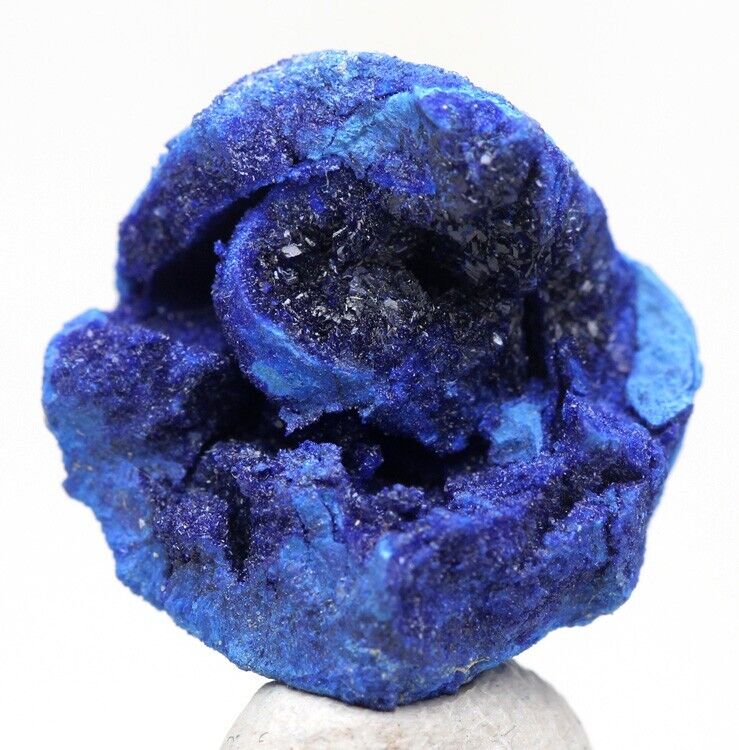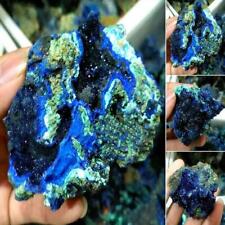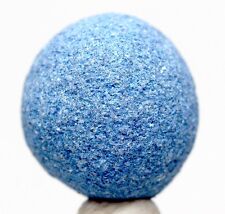AZURITE GEODE Crystal Cluster Mineral Specimen Section Gemstone RUSSIA For Sale

When you click on links to various merchants on this site and make a purchase, this can result in this site earning a commission. Affiliate programs and affiliations include, but are not limited to, the eBay Partner Network.
AZURITE GEODE Crystal Cluster Mineral Specimen Section Gemstone RUSSIA:
$39.99
This specimen weighs 3.33 grams. It measures 17 mm x 17 mm x 11 mm.I offer a shipping discount for customers who combine their payments for multiple purchases into one payment!The discount is regular shipping price for the first item and just 50 cents for each additional item!
To be sure you get your shipping discount just make sure all the items you want to purchase are in your cart.
sales you win are added to your cart automatically.
For any \"buy it now\" items or second chance offers, be sure to click the \"add to cart\" button, NOT the \"buy it now\" button.
Onceall of your items are in your cart just pay for them from your cart andthe combined shipping discount should be applied automatically.I offer a money back guarantee on every item I sell.
If you are not 100% happy with your purchase just send me a message to let me know
and I will buy back the item for your full purchase price. Hi there, I am selling this amazing azurite geode crystal mineral specimen. It is really beautiful. I hope it finds a good home out there, and I am sure it will. This specimen was collected from Mikheyevkoe Deposit, Chelyabinsk Region, South Ural, Russia. It is so sparkly, it\'s just absolutely beautiful to look at! If you have any questions, do not hesitate to ask me. Have fun offerding, thanks so much for visiting my sale and have a great day!
The following is information about this from wikipedia:
AzuriteFrom Wikipedia, the free encyclopediaAzurite may also refer to a blue Green fluorescent protein derivative.For the DFPSO vessel, see Azurite DFPSO.AzuriteAzurit.jpgGeneralCategory Carbonate mineralFormula(repeating unit) Cu3(CO3)2(OH)2Strunz classification 5.BA.05Crystal system MonoclinicCrystal class Prismatic (2/m)(same H-M symbol)Space group P21/cUnit cell a = 5.01 Å, b = 5.85 Åc = 10.35 Å; β = 92.43°; Z = 2IdentificationFormula mass 344.67 g/molColor Azure-blue, Berlin blue, very dark to pale blue; pale blue in transmitted lightCrystal habit Massive, prismatic, stalactitic, tabularTwinning Rare, twin planes {101}, {102} or {001}Cleavage Perfect on {011}, fair on {100}, poor on {110}Fracture ConchoidalTenacity brittleMohs scale hardness 3.5 to 4Luster VitreousStreak Light blueDiaphaneity Transparent to translucentSpecific gravity 3.773 (measured), 3.78 (calculated)Optical properties Biaxial (+)Refractive index nα = 1.730 nβ = 1.758 nγ = 1.838Birefringence δ = 0.108Pleochroism Visible shades of blue2V angle Measured: 68°, calculated: 64°Dispersion relatively weakReferences [1][2][3]Azurite is a soft, deep blue copper mineral produced by weathering of copper ore deposits. It is also known as Chessylite after the type locality at Chessy-les-Mines near Lyon, France.[2] The mineral, a carbonate, has been known since ancient times, and was mentioned in Pliny the Elder\'s Natural History under the Greek name kuanos (κυανός: \"deep blue,\" root of English cyan) and the Latin name caeruleum.[4] The blue of azurite is exceptionally deep and clear, and for that reason the mineral has tended to be associated since antiquity with the deep blue color of low-humidity desert and winter skies. The modern English name of the mineral reflects this association, since both azurite and azure are derived via Arabic from the Persian lazhward (لاژورد), an area known for its deposits of another deep blue stone, lapis lazuli (\"stone of azure\").
Contents [hide]1 Mineralogy1.1 Color1.2 Weathering2 Uses2.1 Pigments2.2 Jewelry2.3 Collecting2.4 Prospecting3 History4 Gallery of azurite mineral specimens5 See also6 References7 Further reading8 External linksMineralogy[edit]Azurite is one of the two basic copper(II) carbonate minerals, the other being bright green malachite. Simple copper carbonate (CuCO3) is not known to exist in nature. Azurite has the formula Cu3(CO3)2(OH)2, with the copper(II) cations linked to two different anions, carbonate and hydroxide. Small crystals of azurite can be produced by rapidly stirring a few drops of copper sulfate solution into a saturated solution of sodium carbonate and allowing the solution to stand overnight.Chemical structure of azurite (color code: red = O, green = Cu, gray = C, white = H).[5]Azurite crystals are monoclinic. Large crystals are dark blue, often prismatic.[2][3][6] Azurite specimens can be massive to nodular. They are often stalactitic in form. Specimens tend to lighten in color over time due to weathering of the specimen surface into malachite. Azurite is soft, with a Mohs hardness of only 3.5 to 4. The specific gravity of azurite is 3.77 to 3.89. Azurite is destroyed by heat, losing carbon dioxide and water to form black, copper(II) oxide powder. Characteristic of a carbonate, specimens effervesce upon treatment with hydrochloric acid.
Color[edit]The optical properties (color, intensity) of minerals such as azurite and malachite are characteristic of copper(II). Many coordination complexes of copper(II) exhibit similar colors. As explained within the context of ligand field theory, the colors result from low energy d-d transitions associated with the d9 metal center.
Weathering[edit]Azurite is unstable in open air with respect to malachite, and often is pseudomorphically replaced by malachite. This weathering process involves the replacement of some the carbon dioxide (CO2) units with water (H2O), changing the carbonate:hydroxide ratio of azurite from 1:1 to the 1:2 ratio of malachite:
2 Cu3(CO3)2(OH)2 + H2O → 3 Cu2(CO3)(OH)2 + CO2From the above equation, the conversion of azurite into malachite is attributable to the low partial pressure of carbon dioxide in air. Azurite is also incompatible with aquatic media, such as saltwater aquariums.
Uses[edit]
Ground azurite for use as a pigmentPigments[edit]
The background of Lady with a Squirrel by Hans Holbein the Younger was painted with Azurite
The greenish tint of the Madonna\'s mantle in Raphael Madonna and Child Enthroned with Saints is due to azurite weathering to malachiteAzurite is not a useful pigment because it is unstable in air. It was however used as a blue pigment in antiquity.[7] Azurite is naturally occurring in Sinai and the Eastern Desert of Egypt. It was reported by F. C. J. Spurrell (1895) in the following examples; a shell used as a pallet in a Fourth Dynasty (2613 to 2494 BCE) context in Meidum, a cloth over the face of a Fifth Dynasty (2494 to 2345 BCE) mummy also at Meidum and a number of Eighteenth Dynasty (1543–1292 BCE) wall paintings.[8] Depending on the degree of fineness to which it was ground, and its basic content of copper carbonate, it gave a wide range of blues. It has been known as mountain blue or Armenian stone, in addition it was formerly known as Azurro Della Magna (from Italian). When mixed with oil it turns slightly green. When mixed with egg yolk it turns green-grey. It is also known by the names blue bice and blue verditer, though verditer usually refers to a pigment made by chemical process. Older examples of azurite pigment may show a more greenish tint due to weathering into malachite. Much azurite was mislabeled lapis lazuli, a term applied to many blue pigments. As chemical analysis of paintings from the Middle Ages improves, azurite is being recognized as a major source of the blues used by medieval painters. Lapis lazuli was chiefly supplied from Afghanistan during the Middle Ages, whereas azurite was a common mineral in Europe at the time. Sizable deposits were found near Lyons, France. It was mined since the 12th century in Saxony, in the silver mines located there.[9]
Heating can be used to distinguish azurite from purified natural ultramarine blue, a more expensive but more stable blue pigment, as described by Cennino D\'Andrea Cennini. Ultramarine withstands heat, whereas azurite converts to black copper oxide. However, gentle heating of azurite produces a deep blue pigment used in Japanese painting techniques.
Jewelry[edit]Azurite is used occasionally as beads and as jewelry, and also as an ornamental stone. However, its softness and tendency to lose its deep blue color as it weathers limit such uses. Heating destroys azurite easily, so all mounting of azurite specimens must be done at room temperature.
Collecting[edit]The intense color of azurite makes it a popular collector\'s stone. However, bright light, heat, and open air all tend to reduce the intensity of its color over time. To help preserve the deep blue color of a pristine azurite specimen, collectors should use a cool, dark, sealed storage environment similar to that of its original natural setting.
Prospecting[edit]While not a major ore of copper itself, the presence of azurite is a good surface indicator of the presence of weathered copper sulfide ores. It is usually found in association with the chemically very similar malachite, producing a striking color combination of deep blue and bright green that is strongly indicative of the presence of copper ores.
History[edit]The use of azurite and malachite as copper ore indicators led indirectly to the name of the element nickel in the English language. Nickeline, a principal ore of nickel that is also known as niccolite, weathers at the surface into a green mineral (annabergite) that resembles malachite. This resemblance resulted in occasional attempts to smelt nickeline in the belief that it was copper ore, but such attempts always ended in failure due to high smelting temperatures needed to reduce nickel. In Germany this deceptive mineral came to be known as kupfernickel, literally \"copper demon\". The Swedish alchemist Baron Axel Fredrik Cronstedt (who had been trained by Georg Brandt, the discoverer of the nickel-like metal cobalt) realized that there was probably a new metal hiding within the kupfernickel ore, and in 1751 he succeeded in smelting kupfernickel to produce a previously unknown (except in certain meteorites) silvery white, iron-like metal. Logically, Cronstedt named his new metal after the nickel part of kupfernickel.

Related Items:
AZURITE GEODE Crystal Cluster Mineral Specimen Section Gemstone RUSSIA
$39.99
New Azurite Malachite Geode Crystal Natural Mineral Specimen Reiki Healing Stone
$17.85
Azurite Specimen Ball Geode Crystal NODULE Mineral Blue Ball Mine Arizona RARE
$7.95



